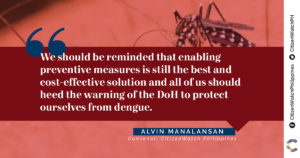Mobilizing resources vs. dengue
August 7, 2019
Originally published in Business World
According to the latest situational report released by the National Disaster Risk Reduction and Management Council (NDRRMC), several provinces and municipalities, particularly in regions IV-A, IV-B, VI, VIII and XII, are now under a state of calamity due to the continuous surge of dengue cases.
Under the Philippine Disaster Risk Reduction and Management Act (Republic Act 10121), Local Government Units (LGUs) who have declared a state of calamity will be allowed to utilize 5% of their estimated annual revenue. This fund, also known as the “Local Disaster Risk Reduction and Management Fund,” comprises of 30% allocation for a Quick Response Fund that serves as a stand-by fund for relief and recovery programs, while the remaining 70% can be utilized for pre-disaster measures. Further, this fund can be used by the LGUs for additional mitigation measures, such as purchase of rapid test kits, medicines and supplies, and/or mosquito nets in order to arrest the spread of dengue.
A National Dengue Alert was declared by the Department of Health (DoH) as early as July 15 this year. Since then, the DoH has already augmented the necessary medical supplies and anti-dengue paraphernalia (e.g. medicines, spray cans, insecticide-treated screens, micronutrients, and first aid kits) worth P6.9 million to the affected areas. The agency also provided a total of P27 million as financial assistance that was sub-allotted to the initially affected seven regions.
For operational purposes, the DoH has also created the National Dengvaxia Task Force, and Health Secretary Francisco Duque III appointed Regional Director Eduardo Janairo of DoH Region VI-A to cover Central Luzon, Calabarzon, and the National Capital Region (NCR). The main role of the task force is to properly address and manage the concerns of those previously vaccinated with Dengvaxia and effectively monitor those vaccinated in those regions by creating a database and registry of each profiled child.
On the Philippine Health Insurance Corp. (PhilHealth) side, patients admitted with dengue or severe dengue will respectively be eligible to a case rate of P10,000 or P16,000. Moreover, patients who contracted the non-severe type of dengue and can be treated in primary care facilities like rural health units, can avail a package worth P7,000. These case rate packages, which are usually divided into 70% health care institution fee and 30% professional fee, are the fixed rate amount that the PhilHealth will reimburse for dengue.
Dengue-related PhilHealth reimbursements have been recently subject to scrutiny in the Senate due to the large disparity in the actual number of cases reported by the DoH as compared to the dengue-related claims. According to Senate President Pro Tempore Ralph Recto, “there is almost a 70,000 difference between PhilHealth receiving 174,000 claims and the DoH only reporting 106,630 cases from January to June of this year.” He stated that authorities should provide an explanation for the gap, but also mentioned that “whether the figure came from DoH or PhilHealth, the current number of dengue cases is still alarming.” He urged the DoH to tap its P500 million Quick Response Fund in the National Disaster Risk Reduction and Management Fund so it can “intensify its response to this public health emergency.”
The Philippine Red Cross (PRC), as member of the health cluster, is continuously supporting the efforts of the DoH and other agencies in controlling the spread of dengue. Trusting the good cause of this organization, the European Union extended its resources and donated €100,000 (around P5.69 million) and this assistance would benefit approximately 300,000 people in NCR, Calabarzon, Central Luzon, Central Visayas and Western Visayas regions. Similarly, the Philippine Charity Sweepstakes Office, also recently donated P10 million to the PRC.
Senator Richard J. Gordon, who is the PRC Chairman, said that the “real solution to dengue is a massive cleanup.” In line with this, he sent a memorandum directing all PRC chapters nationwide to organize “Red Cross 143” volunteering programs on the ground to conduct clean-up campaigns and destroy mosquito breeding sites that can be found in places where these may go unnoticed such as canals, flower vases, plants, old tires, construction debris, uncollected garbage, gutters and the like.
In a press statement released by Malacañang, it expressed that the President would listen to the recommendations of the DoH on whether to restore or not the Dengvaxia vaccine program to address the current outbreak. This comes after the World Health Organization recently included Dengvaxia in its essential medicine list, with findings that the dengue vaccine “prevents disease in the majority of vaccine recipients but it should not be administered to people who have not previously been infected with dengue virus.” The Palace also mentioned that while waiting for these recommendations, the government will continuously provide support in two aspects, namely, prevention programs and treatment of those who were already sick.
Given enough resources that could be mobilized to address the dengue alert, we should be reminded that enabling preventive measures is still the best and cost-effective solution and all of us should heed the warning of the DoH to protect ourselves from dengue.
